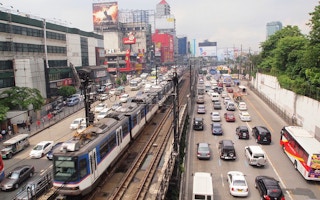Congestion remains an uncomfortable part of life in many of Southeast Asia’s rapidly urbanising cities.
To continue reading, subscribe to Eco‑Business.
There's something for everyone. We offer a range of subscription plans.
- Access our stories and receive our Insights Weekly newsletter with the free EB Member plan.
- Unlock unlimited access to our content and archive with EB Circle.
- Publish your content with EB Premium.
In Indonesia, Jakarta’s citizens spend over 400 hours, or 17 days a year in traffic, while Metro Manila has the dubious distinction of having the worst traffic on earth. Crowded roads are estimated to cost Asian economies 2 to 5 per cent of GDP in lost productivity every year. It can also cost lives – most of Southeast Asia’s air pollution comes from traffic in highly urbanized areas.
Despite all this, vehicle ownership is projected to go up, not down. Rising disposable incomes means there is a strong aspirational drive among Southeast Asia’s growing middle classes, who see cars as a status symbol. The region’s motorcycle owners are also expected to upgrade to four-wheeled vehicles, representing a large pool of first-time car buyers.
Frustration with patchy public transport systems further raises the allure of a private vehicle – creating a potentially vicious circle where more cars on the road will exacerbate traffic jams. According to research by DBS bank, car ownership in Thailand, Indonesia and Malaysia is set to rise by 10.5 per cent per year until 2020 at least.
Sharing is caring
While this sounds like a perfect storm for Southeast Asia’s roads, it also presents a unique opportunity for players in the mobility space to nudge commuters toward more sustainable modes of transport.
Carpooling is one example: It optimises each vehicle to carry more passengers, alleviates congestion and cuts carbon emissions. A study by the Massachusetts Institute of Technology (MIT) discovered that the extent to which traffic jams can be reduced is significant – it projected that using carpooling services could reduce the number of taxis on the road by 75 per cent.
Tech-enabled pooling is still in the early stages of growth in the region but its impact can be tremendous. With Southeast Asia’s relatively youthful population and low car penetration rates – only 6 per cent of Filipino households own a car, while the figure is 4 and 2 per cent in Indonesia and Vietnam, respectively – commuting patterns are still malleable. There is enormous scope to influence mind-sets and behaviours in favour of vehicle sharing.
It should be said that carpooling is not the only solution to the region’s woes. It can exist within a larger public transport infrastructure ‘mix’ that includes efficient buses, train services and ride-sharing options for first- and last-mile commutes.
But until the region’s public transport infrastructure catches up, it is an attractive option that shouldn’t be dismissed. If tech and service providers move fast, they could transform the mindsets and behaviours of an entire generation of would-be and first-time car owners: Shifting them away from owning and/or using a personal vehicle, to sharing one with others.
Southeast Asia is ready to share
The basic ingredients for a shared mobility eco-system are already present in the region. First, demographic factors weigh in favour of a sharing economy: Southeast Asia boasts large, densely populated urban centres – the region has 12 mega-cities with populations in excess of 2 million; and, sizeable working age populations. In particular, Malaysia and Vietnam have a sizeable proportion of millennials (28 per cent and 27 per cent respectively), the age group most likely to engage in the sharing economy.
And unlike the US, where the car is seen as one’s private domain, this mindset is not as entrenched in Southeast Asia. In parts of the region, there have been traditions of either formally or informally sharing vehicles. One of Metro Manila’s most ubiquitous transport options is the jeepney, a kind of open-air ‘car sharing’ taxi system. Indonesians will recall the state’s ‘three-in-one’ traffic restriction policy (which ran from the mid-90s until 2016), which mandated that cars travelling through Jakarta’s main roads had to have at least three passengers. Informal carpooling is a social custom amongst Indonesians, who give lifts to their wider friend circle so frequently that the Javanese have a slang term nebeng which means to request a free ride.
Finally, the social element of pooling may find pull in parts of Southeast Asia where rapid urbanisation has strained traditional community ties. Our user surveys in Jakarta show that one of the key motivations for sharing a ride is having a companion during lengthy – sometimes lonely – commutes. We have observed drivers accepting payments in kind in lieu of cash (like drinks or snacks) from regular passengers. The opportunity to build a connection with another human being is certainly a draw.
How tech providers can drive the way to a sustainable future
With these ingredients in place – geography, demographics and culture – tech providers have a tremendous opportunity to instil a ‘pooling mindset’ among commuters and vehicle owners.
Besides providing a platform that matches drivers with fellow riders, they must be flexible enough to adapt vehicle sharing solutions to local conditions. The region’s transport landscape is too diverse for a one-size-fits-all solution.
At Grab, we found that cities with high levels of congestion, low car ownership but high motorcycle ownership, could be primed as markets for ‘bike pooling’; motorcycles can weave in and out of traffic in ways a car cannot. Hence, our first entry into the ride-sharing space in Jakarta last year was via a motorbike pooling service called GrabHitch (Nebeng). In contrast, we piloted the GrabHitch service with cars in Malaysia and Singapore, as both cities have higher car penetration rates.
Finally, tech providers play a role in building trust so that vehicle sharing is seen as a safe option – especially in places where carpooling is uncommon and social trust is low. If a platform is able to thoroughly verify drivers and passengers, that would help build confidence in ride sharing services.
Powering ahead on a shared journey
Much like the situation on its roads, Southeast Asia’s traffic issues are complex and require
multifaceted solutions. Pooling rides can be a powerful addition to the region’s transport mix. To reference the spirit of gotong royong (communal or mutual aid) in Southeast Asian cultures, it can be said that the future of region surely lies in sharing its roads, its cars and its commutes.
Ngiam Xin Wei is director of strategy at Grab. This post was written exclusively for Eco-Business.









